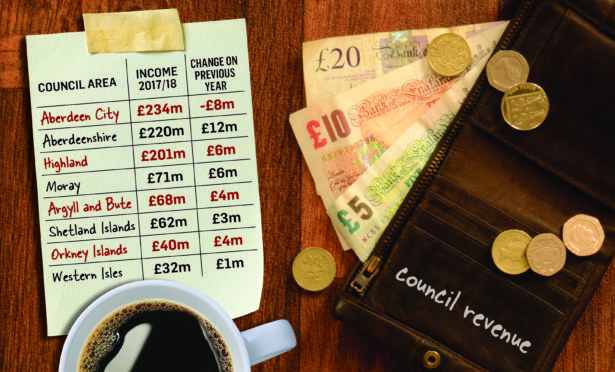Local authorities in the north and north-east will soon be raising more than £1 billion each year in extra revenue as they hike charges and fees to help plug funding gaps.
Official figures – which include all revenue at the eight councils in northern Scotland, apart from core funding, rates and taxes – show that their income reached £928 million in 2017/18, up from £899m the previous year.
Aberdeen City, Aberdeenshire and Highland councils each generated more than £200m in additional income last year, putting all three in the top 10 in Scotland.
And a combined total of more than £270m was also raised last year by the authorities covering Moray, Argyll and Bute, Shetland Islands, Western Isles and Orkney Islands.
Council chiefs admitted last night that they were being forced to attempt to become more “business-like” in their operations, as they struggle to balance the books amid real-terms funding cuts and rising demand.
>> Keep up to date with the latest news with The P&J newsletter
Once council house rents are stripped from the income figures, the eight councils in Grampian and the Highlands and islands raised just over £700m in extra revenue income last year.
Compared to a decade ago, above-inflation rises have been recorded by Aberdeenshire Council, which took in almost £160m last year on top of housing revenue, as well as Orkney Islands Council and Western Isles Council.
Meanwhile, income solely from sales, fees and charges for council services at the eight authorities topped £241m last year, and hit £1.3bn across all of Scotland’s 32 charges, despite several charging services having been moved into arm’s-length firms.
Huge increases in revenue were posted by most councils in “central services”, which includes licensing, registration of births, deaths and marriages, and the administration of taxes and benefits.
In Aberdeenshire, income from sales, fees and charges in that division was up 145% in the last five years, while in Moray it rose by 134%, and in Aberdeen City it had risen by 127%.
Cash raised by roads and transport departments, which includes parking charges and other traffic management schemes, soared by 58% in Highland over the last five years, by 54% in Aberdeenshire and 20% in Moray.
Highland, Aberdeenshire and Moray councils also recorded rises in income for culture services – which incorporates museums, galleries, leisure and parks – which were all significantly higher than the 27% increase witnessed across Scotland.
Meanwhile, major rises in the revenue gathered through planning departments, in relation to planning applications and building control, were seen at Orkney, Western Isles, Moray, Highland and Argyll and Bute councils.
Many councils have put raising revenue at the heart of strategies to stabilise their finances going forward, while further levies could also be considered, including a so-called “tourist tax” and a workplace parking levy.
Last night, Highland Council leader Margaret Davidson, said: “Right now, where we are, we’ve got to become more business-like.
“Hence prices go up, and we don’t enjoy doing that, but sometimes it’s inevitable to keep services on the road.
“We need to examine ways of making money, which is why we’re pulling together a consultation on a tourist tax.”
Alison Evison, an Aberdeenshire councillor and president of the local government body Cosla, admitted rising charges had “hit many communities hard”.
“Each council has made its own financial choices based on its own priorities. But each one has been faced with the same financial challenges,” she said.
“Councils have also had to increase charges where they can, as Cosla highlighted in our Spending Review publication Fair Funding for Essential Services 2019-20, but these charges have hit many communities hard.
“A fundamental cross-party review of local government finance would allow for innovative thinking across both spheres of government about how to raise revenue for local services.”
A Scottish Government spokesman said: “We continue to ensure that our partners in local government receive a fair funding settlement, despite further cuts to the Scottish Budget from the UK Government.
“We are delivering a funding package of £11.2bn for local authorities this year, which is a real-terms increase in both revenue (1.2%) and capital funding (21.5%) compared to the previous year.
“Twenty councils chose not to increase council tax by the full 4.79% permitted, which would have increased their funding by £30.8m this year.”
